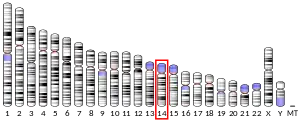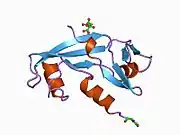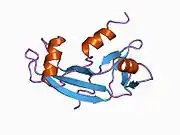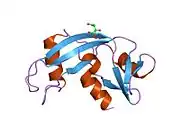Angiogenin
Angiogenin (Ang) also known as ribonuclease 5 is a small 123 amino acid protein that in humans is encoded by the ANG gene.[5] Angiogenin is a potent stimulator of new blood vessels through the process of angiogenesis. Ang hydrolyzes cellular RNA, resulting in modulated levels of protein synthesis and interacts with DNA causing a promoter-like increase in the expression of rRNA.[6][7] Ang is associated with cancer and neurological disease through angiogenesis and through activating gene expression that suppresses apoptosis.[6][8][9]
Function
Angiogenin is a key protein implicated in angiogenesis in normal and tumor growth. Angiogenin interacts with endothelial and smooth muscle cells resulting in cell migration, invasion, proliferation and formation of tubular structures.[5] Ang binds to actin of both smooth muscle and endothelial cells to form complexes that activate proteolytic cascades which upregulate the production of proteases and plasmin that degrade the laminin and fibronectin layers of the basement membrane.[6] Degradation of the basement membrane and extracellular matrix allows the endothelial cells to penetrate and migrate into the perivascular tissue.[5] Signal transduction pathways activated by Ang interactions at the cellular membrane of endothelial cells produce extracellular signal-related kinase1/2 (ERK1/2) and protein kinase B/Akt.[5] Activation of these proteins leads to invasion of the basement membrane and cell proliferation associated with further angiogenesis. The most important step in the angiogenesis process is the translocation of Ang to the cell nucleus. Once Ang has been translocated to the nucleus, it enhances rRNA transcription by binding to the CT-rich (CTCTCTCTCTCTCTCTCCCTC) angiogenin binding element (ABE) within the upstream intergenic region of rDNA, which subsequently activates other angiogenic factors that induce angiogenesis.[5][7][10]
However, angiogenin is unique among the many proteins that are involved in angiogenesis in that it is also an enzyme with an amino acid sequence 33% identical to that of bovine pancreatic ribonuclease (RNase) A.[5] Ang has the same general catalytic properties as RNase A, it cleaves preferentially on the 3' side of pyrimidines and follows a transphosphorylation/hydrolysis mechanism.[11] Although angiogenin contains many of the same catalytic residues as RNase A, it cleaves standard RNA substrates 105–106 times less efficiently than RNase A.[11] The reason for this inefficiency is due to the 117 residue consisting of a glutamine, which blocks the catalytic site.[12] Removal of this residue through mutation increases the ribonuclease activity between 11 and 30 fold.[12] Despite this apparent weakness, the enzymatic activity of Ang appears to be essential for biological activity: replacements of important catalytic site residues (histidine-13 and histidine-114) invariably diminish both the ribonuclease activity toward tRNA by 10,000 fold and almost abolishes angiogenesis activities completely.[13]
Disease
Cancer
Ang has a prominent role in the pathology of cancer due to its functions in angiogenesis and cell survival. Since Ang possesses angiogenic activity, it makes Ang a possible candidate in therapeutic treatments of cancer. Studies of Ang and tumor relationships provide evidence for a connection between the two. The translocation of Ang to the nucleus causes an upregulation of transcriptional rRNA, while knockdown strains of Ang cause downregulation.[5] The presence of Ang inhibitors that block translocation resulted in a decrease of tumor growth and overall angiogenesis.[5][14] HeLa cells translocate Ang to the nucleus independent of cell density. In human umbilical vein endothelial cells (HUVECs), translocation of Ang to the nucleus stops after cells reach a specific density, while in HeLa cells translocation continued past that point.[15] Inhibition of Ang affects the ability of HeLa cells to proliferate, which proposes an effective target for possible therapies.
Neurodegenerative diseases
Due to the ability of Ang to protect motoneurons (MNs), causal links between Ang mutations and amyotrophic lateral sclerosis (ALS) are likely. The angiogenic factors associated with Ang may protect the central nervous system and MNs directly.[5] Experiments with wild type Ang found that it slows MN degeneration in mice that had developed ALS, providing evidence for further development of Ang protein therapy in ALS treatment.[14] Angiogenin expression in Parkinson's disease is dramatically decreased in the presence of alpha-synuclein (α-syn) aggregations. Exogenous angiogenin applied to dopamine-producing cells leads to the phosphorylation of PKB/AKT and the activation of this complex inhibits cleavage of caspase 3 and apoptosis when cells are exposed to a Parkinson's-like inducing substance.[9]
Gene
Alternative splicing results in two transcript variants encoding the same protein. This gene and the gene that encodes ribonuclease, RNase A family, 4 share promoters and 5' exons. Each gene splices to a unique downstream exon that contains its complete coding region.[16]
References
- GRCh38: Ensembl release 89: ENSG00000214274 - Ensembl, May 2017
- GRCm38: Ensembl release 89: ENSMUSG00000072115 - Ensembl, May 2017
- "Human PubMed Reference:". National Center for Biotechnology Information, U.S. National Library of Medicine.
- "Mouse PubMed Reference:". National Center for Biotechnology Information, U.S. National Library of Medicine.
- Gao X, Xu Z (2008). "Mechanisms of action of angiogenin". Acta Biochimica et Biophysica Sinica. 40 (7): 619–624. doi:10.1111/j.1745-7270.2008.00442.x. PMID 18604453.
- Tello-Montoliu A.; Patel J.V.; Lip G.Y.H. (2006). "Angiogenin: a review of the pathophysiology and potential clinical applications". Journal of Thrombosis and Haemostasis. 4 (9): 1864–74. doi:10.1111/j.1538-7836.2006.01995.x. PMID 16961595.
- Xu Z, Tsuji T, Riordan J, Hu G (2003). "Identification and characterization of an angiogenin-binding DNA sequence that stimulate luciferase reporter gene expression". Biochemistry. 42 (1): 121–128. doi:10.1021/bi020465x. PMID 12515546.
- Li S, Yu W, Hu GF (2012). "Angiogenin inhibits nuclear translocation of apoptosis inducing factor in a Bcl-2-dependent manner". Journal of Cellular Physiology. 227 (4): 1639–1644. doi:10.1002/jcp.22881. PMC 3206144. PMID 21678416.
- Steidinger TU, Standaert DG, Yacoubian TA (2011). "A neuroprotective role for angiogenin in models of Parkinson's disease". Journal of Neurochemistry. 116 (3): 334–341. doi:10.1111/j.1471-4159.2010.07112.x. PMC 3048053. PMID 21091473.
- Fu H, Feng J, Liu Q, Sun F, Tie Y, Zhu J, Xing R, Sun Z, Zheng X (2008). "Stress induces tRNA cleavage by angiogenin in mammalian cells". FEBS Letters. 583 (2): 437–42. doi:10.1016/j.febslet.2008.12.043. PMID 19114040.
- Leland PA, Staniszewski KE, Park C, Keleman BR, Raines RT (2002). "The ribonucleolytic activity of angiogenin". Biochemistry. 41 (4): 1343–1350. doi:10.1021/bi0117899. PMID 11802736.
- Russo N, Shapiro R, Acharya KR, Riordan JF, Vallee BL (1994). "Role of glutamine-117 in the ribonucleolytic activity of human angiogenin". Proceedings of the National Academy of Sciences. 91 (9): 2920–2924. Bibcode:1994PNAS...91.2920R. doi:10.1073/pnas.91.8.2920. PMC 43486. PMID 8159680.
- Shapiro R, Valle BL (1989). "Site-directed mutagenesis of histidine-13 and histidine-114 of human angiogenin. Alanine derivatives inhibit angiogenin-induced angiogenesis". Biochemistry. 28 (18): 7401–7408. doi:10.1021/bi00444a038. PMID 2479414.
- Li S, Hu G (2012). "Emerging role of angiogenin in stress response and cell survival under adverse conditions". Journal of Cell Physiology. 227 (7): 2822–6. doi:10.1002/jcp.23051. PMC 3271170. PMID 22021078.
- Tsuji T, Sun Y, Kishimoto K, Olson K, Luo S, Hirukawa S, Hu G (2005). "Angiogenin is translocated to the nucleus of HeLa cells and is involved in ribosomal RNA transcription and cell proliferation". Cancer Research. 65 (4): 1352–1360. doi:10.1158/0008-5472.CAN-04-2058. PMID 15735021.
- "Entrez Gene: ANG angiogenin, ribonuclease, RNase A family, 5".
Further reading
- Saxena SK, Rybak SM, Davey RT, et al. (1992). "Angiogenin is a cytotoxic, tRNA-specific ribonuclease in the RNase A superfamily". J. Biol. Chem. 267 (30): 21982–6. PMID 1400510.
- Weremowicz S, Fox EA, Morton CC, Vallee BL (1991). "The placental ribonuclease inhibitor (RNH) gene is located on chromosome subband 11p15.5". Genomics. 8 (4): 717–21. doi:10.1016/0888-7543(90)90260-2. PMID 2276743.
- Shapiro R, Riordan JF, Vallee BL (1986). "Characteristic ribonucleolytic activity of human angiogenin". Biochemistry. 25 (12): 3527–32. doi:10.1021/bi00360a008. PMID 2424496.
- Weiner HL, Weiner LH, Swain JL (1987). "Tissue distribution and developmental expression of the messenger RNA encoding angiogenin". Science. 237 (4812): 280–2. Bibcode:1987Sci...237..280W. doi:10.1126/science.2440105. PMID 2440105.
- Bicknell R, Vallee BL (1988). "Angiogenin activates endothelial cell phospholipase C". Proc. Natl. Acad. Sci. U.S.A. 85 (16): 5961–5. Bibcode:1988PNAS...85.5961B. doi:10.1073/pnas.85.16.5961. PMC 281885. PMID 2457905.
- Bicknell R, Vallee BL (1989). "Angiogenin stimulates endothelial cell prostacyclin secretion by activation of phospholipase A2". Proc. Natl. Acad. Sci. U.S.A. 86 (5): 1573–7. Bibcode:1989PNAS...86.1573B. doi:10.1073/pnas.86.5.1573. PMC 286740. PMID 2646638.
- Lee FS, Vallee BL (1989). "Characterization of ribonucleolytic activity of angiogenin towards tRNA". Biochem. Biophys. Res. Commun. 161 (1): 121–6. doi:10.1016/0006-291X(89)91569-6. PMID 2730651.
- Lee FS, Vallee BL (1989). "Binding of placental ribonuclease inhibitor to the active site of angiogenin". Biochemistry. 28 (8): 3556–61. doi:10.1021/bi00434a061. PMID 2742853.
- Strydom DJ, Fett JW, Lobb RR, et al. (1986). "Amino acid sequence of human tumor derived angiogenin". Biochemistry. 24 (20): 5486–94. doi:10.1021/bi00341a031. PMID 2866794.
- Kurachi K, Davie EW, Strydom DJ, et al. (1986). "Sequence of the cDNA and gene for angiogenin, a human angiogenesis factor". Biochemistry. 24 (20): 5494–9. doi:10.1021/bi00341a032. PMID 2866795.
- Shapiro R, Vallee BL (1987). "Human placental ribonuclease inhibitor abolishes both angiogenic and ribonucleolytic activities of angiogenin". Proc. Natl. Acad. Sci. U.S.A. 84 (8): 2238–41. Bibcode:1987PNAS...84.2238S. doi:10.1073/pnas.84.8.2238. PMC 304624. PMID 3470787.
- Rybak SM, Fett JW, Yao QZ, Vallee BL (1987). "Angiogenin mRNA in human tumor and normal cells". Biochem. Biophys. Res. Commun. 146 (3): 1240–8. doi:10.1016/0006-291X(87)90781-9. PMID 3619929.
- Shapiro R, Strydom DJ, Olson KA, Vallee BL (1987). "Isolation of angiogenin from normal human plasma". Biochemistry. 26 (16): 5141–6. doi:10.1021/bi00390a037. PMID 3663649.
- Hu GF, Strydom DJ, Fett JW, et al. (1993). "Actin is a binding protein for angiogenin". Proc. Natl. Acad. Sci. U.S.A. 90 (4): 1217–21. Bibcode:1993PNAS...90.1217H. doi:10.1073/pnas.90.4.1217. PMC 45843. PMID 7679494.
- Moroianu J, Riordan JF (1994). "Identification of the nucleolar targeting signal of human angiogenin". Biochem. Biophys. Res. Commun. 203 (3): 1765–72. doi:10.1006/bbrc.1994.2391. PMID 7945327.
- Moroianu J, Riordan JF (1994). "Nuclear translocation of angiogenin in proliferating endothelial cells is essential to its angiogenic activity". Proc. Natl. Acad. Sci. U.S.A. 91 (5): 1677–81. Bibcode:1994PNAS...91.1677M. doi:10.1073/pnas.91.5.1677. PMC 43226. PMID 8127865.
- Acharya KR, Shapiro R, Allen SC, et al. (1994). "Crystal structure of human angiogenin reveals the structural basis for its functional divergence from ribonuclease". Proc. Natl. Acad. Sci. U.S.A. 91 (8): 2915–9. Bibcode:1994PNAS...91.2915A. doi:10.1073/pnas.91.8.2915. PMC 43485. PMID 8159679.
- Hu GF, Riordan JF, Vallee BL (1997). "A putative angiogenin receptor in angiogenin-responsive human endothelial cells". Proc. Natl. Acad. Sci. U.S.A. 94 (6): 2204–9. Bibcode:1997PNAS...94.2204H. doi:10.1073/pnas.94.6.2204. PMC 20065. PMID 9122172.
External links
- Human ANG genome location and ANG gene details page in the UCSC Genome Browser.
- Human RNASE4 genome location and RNASE4 gene details page in the UCSC Genome Browser.
- Human AMOT genome location and AMOT gene details page in the UCSC Genome Browser.
- Overview of all the structural information available in the PDB for UniProt: P03950 (Human Angiogenin) at the PDBe-KB.
- Overview of all the structural information available in the PDB for UniProt: P21570 (Mouse Angiogenin) at the PDBe-KB.






















